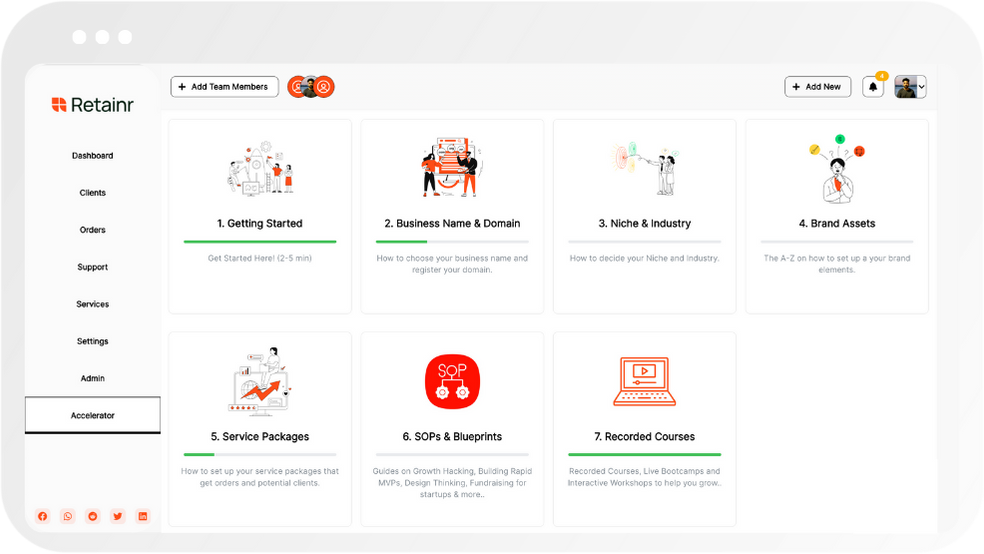
How to implement an effective remote working strategy
Build with Retainr
Sell your products and services, manage clients, orders, payments, automate your client onboarding and management with your own branded web application.
Get Started1. What are the key factors to consider when implementing a remote working strategy?
Key factors to consider for a remote working strategy
Formulating an effective remote working strategy demands a thorough understanding of several key factors. Regulatory compliance, communication, and the right technology tools are foundational to any remote working strategy. Various specific elements, such as those discussed below, must also be incorporated.
- Establish Clear Policies: Clearly outline and communicate the expectations, procedures, and guidelines for remote work. This includes work hours, communication platforms, data security, and performance metrics.
- Focus on Communication: Open and frequent communication is critical in a remote work setting to ensure everyone is on the same page. Regular updates, team meetings, and one-on-ones should be encouraged.
- Ensure Suitable Equipment and Software: Providing the right tools, technology, and equipment is essential for efficient remote work. This may include laptops, project management tools, and secure VPN access.
- Training and Support: Equip your team with the skills and resources needed to work remotely effectively. This includes technical support, professional development opportunities, and employee well-being programs.
- Performance Management: Effective performance tracking and management in a remote setting can be a challenge. Develop fair and transparent policies on how performance will be measured and rewarded.
Comparison of traditional working and remote working strategies
Given the accelerating trend towards remote work, understanding the key differences between traditional and remote working strategies is critical to successful implementation. Below is a brief comparison of the two.
| Traditional Working Strategy | Remote Working Strategy | |
|---|---|---|
| Location | Focused on one specific physical location | Flexible, can work from anywhere |
| Work Hours | Fixed, typically 9-5 | Flexible, as long as work is completed |
| Communication | Primarily face-to-face | Via technology (Email, video conferencing, chat apps etc.) |
| Equipment | Provided by company at workplace | Often provided by company, but used at home |
Key takeaways for implementing remote work strategies
Implementing an effective remote work strategy needs careful consideration and planning. It is crucial to align the strategy with organizational goals, and to regularly refine the approach based on feedback from employees. Implementing effective communication tools, establishing clear policies, personalizing training and support, and equipping your team with the right technology tools will ultimately lead to productive and satisfied remote employees.
2. How can a company ensure effective communication in a remote work setting?
Importance of Effective Communication
Effective communication happens to be the backbone of a successful remote work strategy. By ensuring clear, concise, and frequent communication, a company can establish strong connections among team members, regardless of their geographical location. This contributes to efficient workflows, quick problem-solving, and a healthy work culture.
Tools for Effective Communication
| Tool | Use |
|---|---|
| Slack | This tool enables real-time messaging and file sharing among teams. Slack channels can be created for different departments or projects, simplifying communication. |
| Zoom | Zoom provides a platform for video conferencing, online meetings, chat, and mobile collaboration. It is perfect for meetings and presentations as it allows screen sharing. |
| Trello | Trello is a productivity platform that organizes and prioritizes projects in a flexible way. This tool enables teams to update their work and track others’ progress. |
Communication Strategies for Remote Work
While digital tools are limitless, it’s equally important for businesses to develop and implement effective strategies. Here are some points to ponder:
- Set Clear Expectations: Every team member should be aware of their roles and responsibilities, hours of availability, and deliverable timelines.
- Regular Check-ins: Regular team meetings or one-on-ones can ensure that everyone is on the same page and any issues are addressed promptly.
- Strike the Right Balance: Too many meetings or constant messages can be distracting. It's vital to strike the right balance to ensure constructive communication.
- Encourage Openness: Open communication can foster a sense of trust and teamwork. Encourage employees to share their ideas, feedback, and any challenges they are facing.
3. How should you measure productivity in a remote work environment?
Key Metrics for Measuring Productivity
When it comes to measuring productivity in a remote work environment, there are several key metrics that you should consider. First, assess the quality of work produced by each employee. Be sure to consider factors like accuracy, completeness, and attention to detail. Second, take note of the quantity of work each person is able to complete. Use these two factors to evaluate overall productivity.
- Quality of work - Accuracy, Completeness, Attention to detail
- Quantity of work - Amount of tasks completed
Use Productivity Tools
There are numerous technological tools available that can help in measuring productivity. Project management tools like Trello or Asana enable managers and team leads to track accomplishments of tasks and progress on projects. Time tracking tools like Timely and RescueTime are useful to monitor hours worked and time spent on specific tasks. These tools can provide data for productivity assessment.
- Project Management - Trello, Asana
- Time Tracking - Timely, RescueTime
Productivity Assessment Table Example
To clearly visualize the productivity levels of each remote employee, it is helpful to create a productivity assessment table. The table should include key criteria like task completion, deadline adherence, and quality of work. This can be regularly updated for performance evaluation.
| Name | Task Completion | Deadline Adherence | Quality of Work |
|---|---|---|---|
| Employee 1 | 95% | 90% | 92% |
| Employee 2 | 88% | 95% | 90% |
4. What kind of tools and technology are needed to support an effective remote work strategy?
Required Tools for Effective Remote Working Strategy
In the era of digital workspace, ensuring that teams are equipped with the right tools and technology is imperative for a successful remote work strategy. These tools enable teams to communicate, collaborate, manage tasks and maintain productivity irrespective of their geographical locations.
- Communication Tools: Tools such as Slack, Zoom, Skype, and Microsoft Teams are essential for connecting remote teams. They facilitate instant messaging, video conferencing, and audio calling, thereby replicating face-to-face interactions.
- Project Management Tools: Applications like Asana, Trello, and Jira enable teams to track workflows, assign tasks, and monitor progress. They provide complete visibility over work allocation, thereby ensuring team accountability.
- Document Collaboration Tools: Google Workspace and Microsoft 365 are examples of platforms that allow multiple users to create, edit, and share documents simultaneously. This leads to seamless collaboration and efficient task completion.
- Security Tools: With the rising cybersecurity threats, it is crucial for remote employees to use VPNs, anti-virus software, and encryption tools. These protect sensitive organizational data and maintain the integrity of the virtual workspace.
Choosing the Right Technology for Remote Work
Alongside tools, selecting the correct technology infrastructure is a vital part of a remote work strategy. The objective is to create a consistent, secure, and efficient work environment for all employees, irrespective of their physical locations.
| Technology | Use |
|---|---|
| Cloud-based Services | Cloud services like AWS and Google Cloud provide secure access to data and applications from anywhere. They eliminate the need for physical servers, thereby reducing the IT maintenance burden. |
| Virtual Desktop Infrastructure (VDI) | VDI gives users access to their work desktops from any device. This ensures that remote workers have the identical workspace setup as they would in an office, maintaining a consistent work experience. |
| Internet of Things (IoT) | IoT devices like smart speakers and virtual assistants can help remote workers streamline their tasks and increase efficiency. |
5. How can a company promote a strong work-life balance among remote employees?
Promoting a Strong Work-Life Balance Among Remote Employees
To ensure a healthy work-life balance among remote workers, companies can follow several strategies. First, they can enforce a clear and strict working schedule that discourages working beyond the standard hours, just as they would in an office setting. Second, they can offer flexible work hours, designed to allow workers to adjust their work hours around their personal life. Finally, they can provide support, such as access to counseling or Employee Assistance Programs (EAPs), to help employees manage stress and other work-life balance issues.
| Strategy | Explanation |
|---|---|
| Strict Working Schedule | A clear and strict schedule can help remote workers maintain a separation between work and personal life. This can help them avoid overwork and burnout. |
| Flexible Hours | Allowing flexible work hours provides employees the opportunity to create a schedule that suits their individual needs, making it easier for them to balance work and personal responsibilities. |
| Support Services | Offering access to support services, such as counseling or EAPs, shows employees that their mental health is a priority and can give them a resource for managing stress and improving their work-life balance. |
It's equally important to recognize that motivation and morale can heavily influence an employee's work-life balance. That's why building a strong company culture – even from afar – and giving employees regular feedback can make a significant difference. For example, regular virtual meetups, town halls, or online team games can foster a sense of community. Moreover, using performance management systems, companies can set clear expectations, deliver real-time feedback, and recognize employees who are balancing their work and personal lives successfully.
6. What are the challenges that a company may face when implementing a remote work strategy and how to overcome them?
Challenges of Implementing a Remote Work Strategy
Implementing an effective remote working strategy is not going to come free of challenges. It involves a significant shift in how day-to-day operations are performed and how interactions between employees are executed. The common challenges that can be faced include communication and collaboration challenges, technology and infrastructure issues, and difficulty in monitoring and managing employee performance.
- Communication and Collaboration Challenges: Without physical presence, spontaneous brainstorming and problem-solving can be difficult. This can be resolved by using real-time collaboration tools that allow teams to work simultaneously.
- Technology and Infrastructure Issues: Insufficient technology infrastructure can hinder the flow of work, leading to reduced productivity. Companies should ensure all remote employees have access to necessary hardware and high-speed Internet. Also, workforce should be provided with the essential software tools that aid in productivity and work management.
- Managing Employee Performance: It can be harder to monitor employees' tasks and progress with remote work. This can be overcome by setting clear goals, using performance tracking tools, and maintaining regular check-ins.
Overcoming Challenges in Remote Work Implementation
Addressing these challenges requires systematic planning and the use of modern technology. Moreover, promoting a strong company culture that supports remote work, and providing training to teams about the best practices in remote working can help in overcoming some limitations. The table below presents some useful measures companies can adopt to facilitate remote work implementation:
| Challenge | Proposed Solutions |
|---|---|
| Communication and Collaboration Challenges | Use collaboration tools like Google Docs, Trello, Slack |
| Technology and Infrastructure Issues | Arrange necessary hardware; promote use of productivity tools like Asana, Monday.com |
| Managing Employee Performance | Set clear goals; Use performance tracking tools like Time Doctor, Harvest |
7. How can a business maintain its culture and team dynamics when transitioning to remote work?
Maintaining Business Culture in a Remote Setup
Preserving the company culture and team dynamics is a vital aspect of transitioning to remote work. It's important to create strategies to keep everyone aligned and motivated. Firstly, set clear expectations of how everyone should behave to uphold the business culture. Secondly, endeavor to maintain frequent communication via virtual meetings, emails, or messaging. Lastly, allow time for social interaction via virtual coffee breaks or casual conversations to carefully build and nurture relationships.
Strengthening the Team Dynamics
Adapting to remote work brings changes in the team dynamics. Companies can tackle this by encouraging active involvement of each team member, which can be tracked with project management tools. Offering ongoing training to employees while transitioning could also be beneficial and serve as a proactive measure to keep the team cohesiveness. Essentially, trust needs to be the foundation of remote work setup, and employers need to express faith in their employees' abilities and deliverability.
Techniques and Tools to Champion Remote Transition
Techniques:1. Regular team meetings 2. Virtual team-building activities3. Provision of resources for self-developmentTools:
| Name | Type | Use |
|---|---|---|
| Zoom | Video Conferencing | Used for virtual meetings |
| Slack | Messaging | Used for day-to-day communication |
| Trello | Project Management | Used for tracking project progress |
8. How to effectively manage remote teams and ensure they stay motivated?
Setting Clear Expectations and Monitoring Progress
When managing remote teams, setting clear expectations is crucial. All team members should know what tasks they are responsible for, what the deadlines are, and what standards they need to meet. You can implement project management software like Trello, Asana, or Basecamp to keep track of progress and to assign tasks. Communication tools such as Slack or Microsoft Teams can also be valuable for work-related discussions.
Here is a simplified format of how a remote team task may be structured:
| Task | Assigned To | Deadline | Status |
|---|---|---|---|
| Design website homepage | John | 05/09/2022 | In Progress |
| Write blog post on remote working | Sarah | 03/09/2022 | Completed |
| Create marketing strategy | Mike | 07/09/2022 | Not Started |
Motivating Your Remote Team
Maintaining team motivation can be a challenge when managing remote teams. Consider the following strategies:
- Regular Check-ins: Frequent and regular check-ins allow for connection and feedback. These can be conducted daily or weekly depending on the intensity of the project.
- Encourage Breaks: Encourage your team to take regular breaks for mental relaxation and to avoid burnout. Just because they are working from home does not mean they should be working all the time.
- Telecommuting Perks: Consider giving your employees stipends to set up their home office, or cover their internet bill. This not only boosts morale but also ensures that they have the tools they need to work effectively.
- Recognise Achievements: Recognising and rewarding positive behavior can drastically increase job satisfaction, productivity and thus keep your team motivated.
Managing Conflict in Remote Teams
Conflicts can be harder to manage in remotely working teams as they lack the face-to-face interaction that usually helps in conflict resolution. Use strategies such as open communication, hiring a mediator if necessary, or even scheduling a video call between the parties involved to help resolve these issues. Intervene early and establish norms about respectful behavior even in virtual communications.
9. How often should management check in with remote employees, and what should these check-ins entail?
Frequency and Importance of Checking In with Remote Employees
The frequency with which management should check in with remote employees varies depending on the nature of the work, individual styles and the level of autonomy of a given team, but a good rule of thumb is weekly. Studies show that weekly check-ins maintain a steady line of communication while still granting employees independence.
- Regular Updates: Weekly check-ins ensure timely updates on projects, tasks and any critical issues that need to be resolved.
- Feedback: Providing and receiving feedback is critical to catch any issues early and make necessary changes to avoid major mishaps in the future.
- Maintain Connection: Regular communication helps maintain a connection to the organization and team, building a sense of togetherness, which is especially important in a remote work setting.
What Should Check-ins Entail?
The check-ins should not only be about work progress, but should also aim to assess the overall well-being and job satisfaction of remote employees. They should entail the following:
| Component | Description |
|---|---|
| Work Progress | Discuss tasks or projects that the employee is currently working on, provide feedback on work completed, and set goals for the following week. |
| Challenges and Problems | Ask about any difficulties in the work or in the process of remote working, provide solutions or guidance. |
| Well-being Check | Ask about the employee’s physical and mental wellbeing, which helps show empathy and concern for the employee. |
| Support and Resources | Find out what support or resources the employee might need to increase productivity and satisfaction. |
Overall, regular check-ins and their content should be tactfully planned and executed. This way, the management will be able to ensure that the remote working strategy is effective and beneficial for both the company and the employees.
10. How should an organization handle scheduling and time management when implementing a remote work policy?
Scheduling Strategies for Remote Work
When implementing a remote work policy, organizations should offer a flexible scheduling system. This can accommodate employees in different time zones or those who need to balance work and home responsibilities. There are three key aspects to this:
- Define core working hours: Define the specific hours during a day when all team members must be available for meetings and collaborative work.
- Allow for flex-time: Beyond core working hours, allow employees to complete their individual tasks at times that work best for them.
- Respect off-hours: Ensure that employees are not expected to respond to work communication during their off-hours, unless it’s a job requirement.
Time Management Strategies for Remote Working
Efficacious time management is crucial while implementing remote work policy. Effective time management not only improves individual productivity but also ensures harmonious team operations.
| Strategies | Description |
|---|---|
| Time tracking tools | These tools allow for transparency and accountability, making it easier for teams to stay on track with their deadlines and for managers to measure productivity. |
| Task management systems | These platforms allow for assigning, tracking, and completing tasks in a structured manner. They can also automate routine tasks, saving time and preventing errors. |
| Regular check-ins | Regular check-ins between managers and their team members can help to maintain focus, offer assistance with prioritization, and preemptively address any issues or challenges. |
Creating a Balance Between Scheduling and Time Management
Striking the balance between flexible scheduling and effective time management can be challenging. By defining clear expectations and availability, using productivity tools, and conducting regular check-ins, organizations can successfully navigate this in remote work arrangements. It's crucial to keep these principles in mind:
- Create transparent communication channels.
- Encourage a culture of accountability and trust.
- Allow flexibility but also maintain structure and routine.
- Offer support and training on using productivity tools.
- Regularly review and refine the remote working strategy based on feedback.
Conclusion
Implementing an Effective Remote Working Strategy
As the world moves towards a diversified work culture, remote working has become an integral part of many organizations. To devise an effective remote working strategy, businesses need to ensure seamless communication, efficient project management, transparency, and a high level of coordination amongst the team members.
Introducing Retainr.io
To enhance business operations and make remote working more efficient, Retainr.io, a comprehensive white-label software solution has been tailored to meet your needs. With Retainr.io, businesses can effortlessly sell, manage clients, orders and payments while enabling their employees to work remotely.
Key Features of Retainr.io
The software boasts diverse features to help your business grow. This includes a unique, interactive interface for managing clients and orders, which simplifies task assignment and allows you to track progress in real-time. The end-to-end encryption secures all your transactions, ensuring that all the data remains confidential and secure.
Efficient Remote Working With Retainr.io
Retainr.io, with its diverse features, makes remote working a breeze. The ease of managing clients and orders right from the comfort of your home, in addition to secure payment handling, promises a smooth remote work experience, thereby making your team more productive.
Conclusion
Managing your team remotely doesn't have to be a daunting task. With the right tools like Retainr.io at your disposal, creating an effective remote working strategy can be simple, straightforward, and more importantly, successful.
Boost Your Agency Growth
with Retainr Accelerator
Uncover secrets, strategies, and exclusive blueprints to take your agency's growth to the next level — from marketing insights to effective presentations and leveraging technology.

SOPs, Cheatsheets & Blueprints
Leverage 50+ SOPs (valued over $10K) offering practical guides, scripts, tools, hacks, templates, and cheat sheets to fast-track your startup's growth.
Connect with fellow entrepreneurs, share experiences, and get expert insights within our exclusive Facebook community.
.jpg)

Join a thriving community of growth hackers. Network, collaborate, and learn from like-minded entrepreneurs on a lifelong journey to success.

Gain expertise with recorded Courses, Live Bootcamps and interactive Workshops on topics like growth hacking, copywriting, no-code funnel building, performance marketing and more, taught by seasoned coaches & industry experts.

.jpg)

.jpeg)


